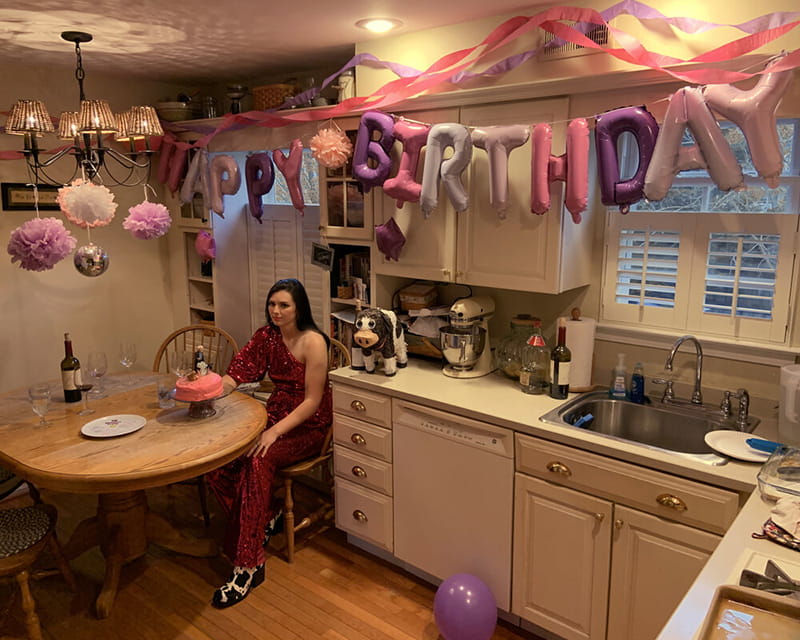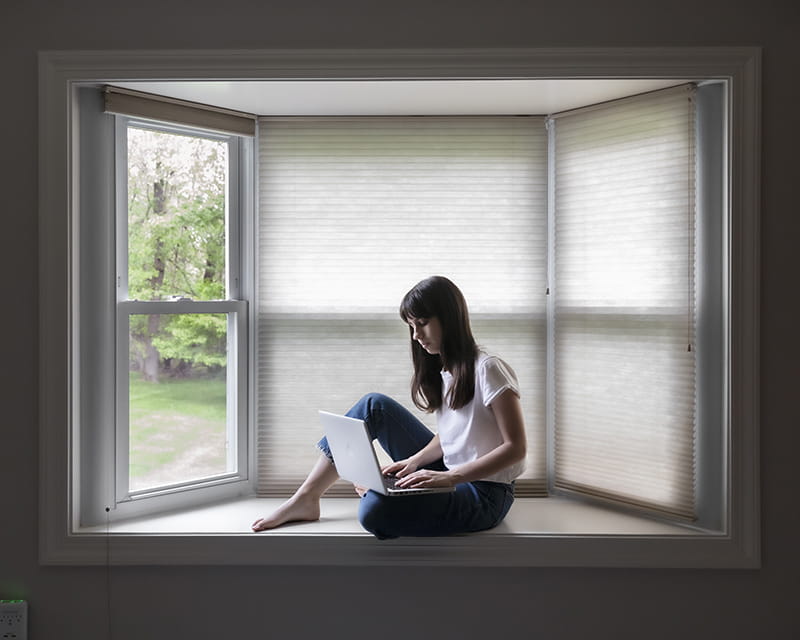Three Drexel Student Projects Making a Difference During COVID-19

When the world as they knew it halted for many Dragons back in March before spring term began, the many changes to daily life didn’t also change the fact that many Drexel University students — especially seniors — still had classes to take, and final projects to complete.
But in the Dragon way and in keeping with Drexel’s focus on civic engagement, many students took their opportunities in class to focus on how to make a difference in a world still adjusting to the new normal.
Here are just three such stories among many more examples of Drexel student projects from back in the spring term that tackled the COVID-19 pandemic head on, either by documenting, providing advice or by keeping community together.
For the Eyes
Hannah Beier started on her senior photography thesis back in September 2019, photographing the important relationships in her life. It followed the framework of her initial impetus for taking photos in her adolescent and teen years.

“When I was 12, my parents bought me this little Canon PowerShot [camera], and I just began taking photos of anything and everything around me. As I got older, I started to just take photos of my friends,” Beier (BS photography ’20) remembered. “It wasn’t really until I was 17 and struggling in my adolescence that photography really picked up for me. I started to take photos multiple times a week of my friends because they were the people that I connected to most in the world. It gave me a creative outlet and it helped me to feel more grounded in the world that I was living in and struggling through.”
Being with her friends and capturing their final moments of their undergraduate experience at Drexel was what Beier planned to do in the final stage of her senior project, but then the pandemic happened. Beier moved back home with her family and began social distancing, and many of her friends did the same. Having a background in self-portraiture, she started playing around with an idea for capturing this time in her friends’ lives without physically being with them, camera in hand. She would instead conduct remote self- photoshoots — Beier tuning in through Facetime — walking her subjects through the process of turning the camera on themselves in a way that could incapsulate what a lot of others were going through in this time of social distancing and change.
“What was so amazing about this, even though I wasn’t able to be physically clicking the shutter, I was able to be inside all of my friends’ homes growing up, which I wouldn’t have been able to do had I not been doing this project,” Beier said. “So, I was able to capture more of an authentic take about where they came from and who they are.
“…You’re seeing the mix of all of these emotions, and there’s things we can all relate to,” she continued. “We’re all going through being quarantined, and we’re all going through living through a pandemic. But there’s still so much more happening in our lives than just the day-to-day of being in a pandemic. There’s still these very real, authentic moments that I wanted to capture.”
Then, TIME magazine came knocking — asking several university photography departments throughout the country, including Drexel, for COVID-19-related student work. Photography Professor Andrea Modica sent Beier’s pandemic-era thesis work, and the publication expressed interest in running not just one image, but in a whole photo spread including a cover, and an interview with Beier about the project.
We'd like to offer a massive congratulations to Hannah Beier ’20, a senior in the @DrexelPhoto program at @DrexelWestphal, whose senior thesis project is currently featured on the cover of @TIME Magazine! https://t.co/ojxWSm7DdR pic.twitter.com/cS4JTFCNm0
— Drexel University (@DrexelUniv) May 21, 2020
“This is the first time that I’d ever had my work published,” Beier said. “For me, I’ve just been so focused on school and in the moment with these projects. I wasn’t worried about the world seeing my work. I knew that it would happen eventually, but not in my wildest dreams could I have imagined being on the cover of TIME at the age of 23. For me, that was like an end goal.”
All in all, the project became “a moment of hope” for Beier in the early days of the pandemic, and also helped serve as a way for her to accomplish the main objective of her photography.
“It made me just continue to want to be on the path of creating positive change in the world,” she said of the project and the notoriety it brought her. “So, just being able to continue with that work and hopefully carry that into what I do post-graduation, that’s where I want to end up, just continuing to do work that makes a difference in the world. I don’t think it really changed how I felt or what I wanted to do, it just kind of propelled it.”
For the Ears

“I knew any class she taught even if it was going to be online would be interesting and I would learn so much from it,” Khurana said, and her notions were right, though she couldn’t have guessed then how much one of her class assignments would help in the context of the pandemic.
D’Innocenzo assigned the class to create podcast-style recordings with advice on managing stress. This resonated with Khurana, as her research for the assignment unearthed a lot of outlets providing the same type of coping strategies in light of the pandemic, though many of them never really clicked with Khurana.
“I didn’t really resonate with a lot of the buzz words I was hearing, like ‘eat healthy,’ ‘work out,’ ‘self-care.’ I still to this day am struggling to figure out what self-care really is,” she said. “For some people it’s just putting on a face mask, and for some people it’s totally different. For me, I took this podcast project as a large point of self-reflection where I was seeing what I do in my daily life or weekly life where I am having a very different mindset than when I’m at work and in classes. I think that’s the main source of stress for people. So for me, it was really the mind shift, and that’s how I identified the five ways that I handle stress.”
In her five-minute podcast, Khurana explains all of this and outlines simple, attainable destressing tactics for those who are leaders in the workplace, or those just focused on the day-to-day of their own life. These include: connecting with friends, as physical distancing doesn’t have to mean social distancing; taking time to center yourself, though this doesn’t necessarily have to mean meditation; cleaning out a space in your home that you’re not happy with; and taking at least one day a week away from social media.
Khurana hopes these tips are practical for a lot of different people to utilize, connect on and maintain a fulfilling lifestyle during the pandemic.
“I think a lot of people are feeling like they’re helpless. They can’t do anything right now, which is not untrue, and they’re feeling that way because it’s just fact at this point,” she said. “But in terms of everyone feeling that way, I think it’s also really important to see the positives in it.”
For the Community

Eric Hegnes (BS computer science ’20) got involved with a senior design project at the beginning of the last academic year that not only piqued his interest from a technical aspect, but also helped a good cause — one that would become all the more relevant due to COVID-19-induced social distancing.
He and his fellow College of Computing & Informatics students helped bring the Blue Skies app — an idea from New Jersey-based nonprofit Project Refit — to life, providing a social media-like platform exclusively for members of the military, veterans and first responders.
“I like the programming and data structures, the intricacies and security aspects, the performance [of the app],” Hegnes said. “And, it’s so much more fulfilling to work on a project that has a cause you can believe in or a cause that you think is valuable, to see through.”
The students, including Hegnes, worked directly with Project Refit President and Co-founder James Corbett, to make his idea (to strengthen and empower friend groups within the military through technological means) a reality. And as meeting spaces like VFW halls and support groups shuttered due to the pandemic, the demand for such virtual solutions became all the more important.
“Those friend groups, they see each other all the time, and then if they lose that contact, it’s a shock, it’s culture shock to some guys,” Corbett said. “That culture shock ends up becoming almost this spiraling behavior of negative thoughts, which leads potentially to suicide. So, if we have a way of allowing these guys to stay in touch easier — by the tap of the button, you can check in on each other — then you have a tool that can really change the game in terms of the outreach and showing ‘Hey, I care about you, and you’re still being thought of and thought about.’”

The app built through student efforts boasts a dashboard component that aggregates content that Project Refit wants to share with the community, as well as an administrative panel to allow individual members to upload their own content, like podcasts, books or whatever they feel to be valuable to the community. There is also a Reddit-like forum and one-to-one chat functionality for service members to connect. And finally, one of the most important features according to Hegnes, is a “radio check” which allows members to connect with friends or others there to help click of a button in times of need, or those available to listen to easily be ready and waiting on the other end of that signal boost.
“Eventually we want to be able to match you a little bit more intelligently based on your branch or your service record, somebody in the community who we feel you might be predetermined to feel better talking to,” Hegnes said.
Even after graduation in June, Hegnes stayed on to work on the project and see it through to its release on the Apple and Android app stores just last month. Corbett said he is also hoping that the excitement around the app and those who are willing to donate toward its success will enable him to hire one or two of the developers, including Hegnes, full time.
“Guys have already said that they’re very excited about having this application that’s exclusive to them for their own community and their own purposes,” Corbett said. “So, there is a lot of excitement around it.”
That excitement stems from the passion, energy and innovation students like Hegnes put into the project, Corbett says. And although it was hard to focus when a pandemic greeted the end of his Drexel experience, Hegnes said it also creates the opportunity for students like him to do some real good — maybe more so now than ever again in their lifetimes.
“If you can, find a project, find a group, find an organization, whatever you can to contribute to,” Hegnes said as advice for current Drexel students making the most of this time period. “The fulfillment you can get from that will help you stay focused and motivated.”
Drexel News is produced by
University Marketing and Communications.
